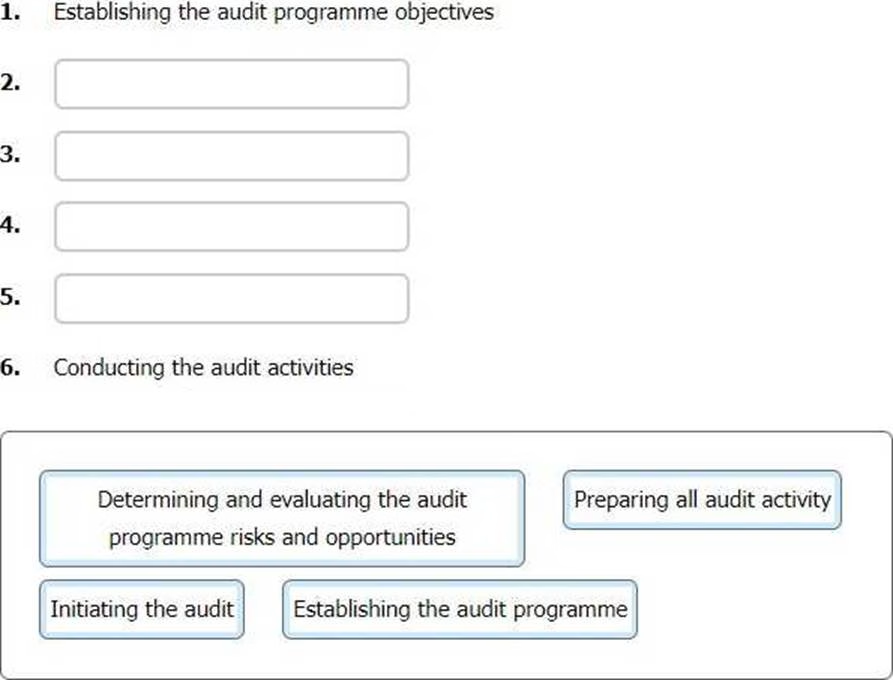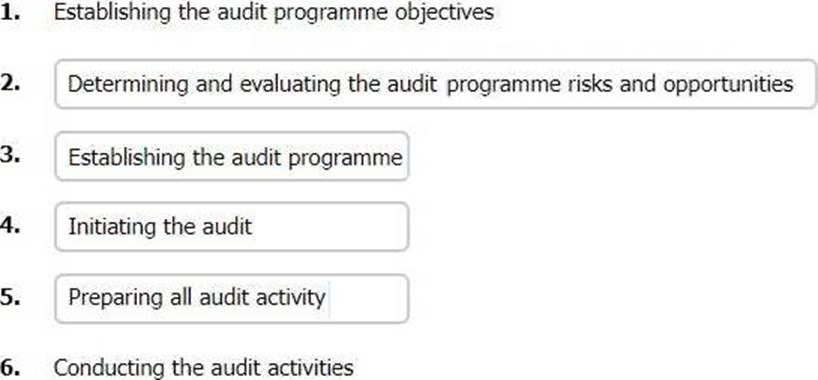The following are stages of an audit, put them in the order they would be conducted
DRAG DROP
The following are stages of an audit, put them in the order they would be conducted.
The first and last stages have been done for you
To complete the sequence click on the bank section you want to complete so it is highlighted in red and then click on the applicable text from the options below.

Answer: 
Explanation:
Establishing the audit programme objectives
Determining and evaluating the audit programme risks and opportunities
Establishing the audit programme
Initiating the audit
Preparing all audit activity
Conducting the audit activities
According to ISO 19011:2018, clause 5, the audit programme is a set of one or more audits planned for a specific time frame and directed towards a specific purpose. The audit programme includes all activities necessary to plan, organize, and conduct the audits. The audit programme management involves the following steps1:
Establishing the audit programme objectives: The audit programme objectives define the intended outcomes of the audit programme, such as verifying conformity, evaluating performance, identifying improvement opportunities, etc. The audit programme objectives should be aligned with the strategic direction and policies of the organization and the needs and expectations of the interested parties.
Determining and evaluating the audit programme risks and opportunities: The audit programme
risks and opportunities are the factors that can affect the achievement of the audit programme objectives, such as changes in the internal or external context, availability of resources, competence of auditors, etc. The audit programme risks and opportunities should be identified, analyzed, and evaluated to determine the appropriate actions to address them.
Establishing the audit programme: The audit programme is established by defining the audit programme scope, criteria, methods, and resources. The audit programme scope defines the extent and boundaries of the audit programme, such as the processes, functions, sites, activities, etc. that will be audited. The audit programme criteria are the set of policies, procedures, or requirements used as a reference for the audits. The audit programme methods are the techniques used to conduct the audits, such as interviews, observations, document review, sampling, etc. The audit programme resources are the human, technical, and financial resources needed to implement the audit programme.
Initiating the audit: The audit initiation is the process of formally establishing the arrangements for an individual audit within the audit programme. The audit initiation involves contacting the auditee and the audit client, confirming the audit objectives, scope, and criteria, and obtaining the necessary information and access for the audit.
Preparing all audit activity: The audit preparation is the process of developing the audit plan and the audit work documents for an individual audit. The audit plan is a document that provides the basis for agreement regarding the conduct of the audit, such as the audit schedule, the audit team, the audit methods, the audit language, the audit report, etc. The audit work documents are the records that provide evidence of the audit activities, such as the audit checklist, the audit notes, the audit findings, etc.
Conducting the audit activities: The audit activities are the processes of collecting and verifying audit evidence and evaluating it against the audit criteria to make the audit conclusions. The audit activities include the opening meeting, the communication during the audit, the roles and responsibilities of the audit team and the auditee, the audit evidence collection and verification, the audit findings generation and recording, the closing meeting, and the audit report preparation and distribution.
Reference: ISO 19011:2018(en), Guidelines for auditing management systems
Latest ISO-9001 Lead Auditor Dumps Valid Version with 226 Q&As
Latest And Valid Q&A | Instant Download | Once Fail, Full Refund

